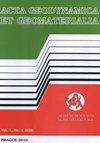Synergetic use of the Sentinel-2, ASTER, and Landsat-8 data for hydrothermal alteration and iron oxide minerals mapping in a mine scale
IF 0.8
4区 地球科学
Q4 GEOCHEMISTRY & GEOPHYSICS
引用次数: 6
Abstract
Many of the known Tertiary porphyry Cu deposits (PCDs) are situated in the Central Iranian Volcanic Belt (CIVB). The study area is located in the southern part of the CIVB and southern part of the Kerman Cenozoic magmatic arc. This research highlights the significance of the synergetic use of operational land imager aboard the Landsat-8 (OLI), Sentinel-2, and advanced space-borne thermal emission and reflection radiometer (ASTER) data for exploration of copper mineralization in a mine scale. Multispectral images in the visible and near infrared bands of (0.451.0 μm) the OLI and Sentinel-2 were used to identify the gossan zones. ASTER short wave infrared (SWIR) data with the wavelength between 1.65 and 2.43 μm were used for mapping hydrothermal alteration zones. Laboratory spectra obtained from minerals such as muscovite and illite (phyllic alteration), kaolinite and montmorillonite (argillic alteration), epidote and chlorite (propylitic alteration) were applied in mixture tuned matched filtering (MTMF) algorithm on the ASTER data to enhance the existence of these minerals. The spectra of the index minerals from each alteration type were used in this algorithm and the abundances of minerals in the MTMF image were rescaled to be within the ranges of 34-54 %, 54-74 % and 74-100 %. The studied mineralized zone is associated with the iron rich phyllic and argillic hydrothermal alteration types which can be best detected by using integrated ASTER, OLI, and Sentinel-2 images. The diamond drill cores data also indicate that copper is more enriched below the gossan zones. The gossan index minerals (GIM) including goethite, jarosite, and hematite were identified by X-ray diffraction (XRD) method, spectral analyses, and petrographic examinations. The Sentinel -2 data proved to provide remarkably better mapping result for iron oxide minerals than the OLI and ASTER data. The directed principal component analysis (DPCA) method, In the data of the Landsat-8 and Sentinel2 were used for mapping of the gossan index minerals such as goethite, jarosite and hematite and the argillic, phyllic and propylitic hydrothermal alteration types were enhanced using the MTMF methods. The hydrothermal alteration pattern and the distribution of the gossans in the study area show a porphyry-type mineralization. This study showed that the synergetic use of different satellite images with different spatial and spectral resolutions can be used for mineral exploration in a large scale. The use of laboratory spectra obtained from hydrothermal alteration minerals in MTMF method depicts that the alteration minerals were mapped more accurately relative to those MTMF images that are derived from standard spectral libraries. The samples collected from the surficial hydrothermal alteration zones as well as diamond drill cores showed that the copper mineralization occurres mainly along the border of the phyllic and argillic alteration zones, and the magnetite mineralization in the propylitic zone. ARTICLE INFOSentinel-2、ASTER和Landsat-8数据在矿山规模的热液蚀变和氧化铁矿物测绘中的协同使用
许多已知的第三纪斑岩型铜矿位于伊朗中部火山带(CIVB)。研究区位于CIVB南段和Kerman新生代岩浆弧南段。该研究强调了协同使用Landsat-8 (OLI)、Sentinel-2上的作战陆地成像仪和先进的星载热发射和反射辐射计(ASTER)数据在矿山规模的铜矿化勘探中的重要性。利用OLI卫星和Sentinel-2卫星(0.451.0 μm)的可见光和近红外多光谱图像对gossan区域进行了识别。利用波长在1.65 ~ 2.43 μm之间的ASTER短波红外(SWIR)数据进行热液蚀变带填图。从白云母和伊利石(叶状蚀变)、高岭石和蒙脱石(泥质蚀变)、绿帘石和绿泥石(丙基蚀变)等矿物中获得的实验室光谱,在ASTER数据上应用混合调谐匹配滤波(MTMF)算法来增强这些矿物的存在性。该算法利用各蚀变类型指标矿物的光谱,将MTMF图像中矿物的丰度调整为34- 54%、54- 74%和74- 100%。研究的矿化带与富铁的叶状和泥质热液蚀变类型有关,利用ASTER、OLI和Sentinel-2综合图像可以最好地探测到矿化带。金刚石岩心资料也表明,铜在粗砂岩带以下更为富集。通过x射线衍射(XRD)、光谱分析和岩石学检查,鉴定了针铁矿、黄钾铁矾和赤铁矿等gosan指标矿物。与OLI和ASTER数据相比,Sentinel -2数据提供了明显更好的氧化铁矿物制图结果。利用Landsat-8和sentinel - 2卫星数据,采用定向主成分分析(DPCA)方法对针铁矿、黄钾铁矾和赤铁矿等goss指标矿物进行了定位,并利用MTMF方法增强了泥质、叶状和丙质热液蚀变类型。研究区热液蚀变模式和蛛丝分布表现为斑岩型成矿。研究表明,协同利用不同空间和光谱分辨率的不同卫星影像,可用于大规模矿产勘查。在MTMF方法中使用从热液蚀变矿物获得的实验室光谱表明,相对于来自标准光谱库的MTMF图像,蚀变矿物的映射更为准确。地表热液蚀变带及金刚石岩心样品表明,铜成矿主要发生在叶状和泥质蚀变带的边缘,磁铁矿成矿主要发生在丙基岩带。条信息
本文章由计算机程序翻译,如有差异,请以英文原文为准。
求助全文
约1分钟内获得全文
求助全文
来源期刊

Acta Geodynamica et Geomaterialia
地学-地球化学与地球物理
CiteScore
2.30
自引率
0.00%
发文量
12
期刊介绍:
Acta geodynamica et geomaterialia (AGG) has been published by the Institute of Rock Structures and Mechanics, Czech Academy of Sciences since 2004, formerly known as Acta Montana published from the beginning of sixties till 2003. Approximately 40 articles per year in four issues are published, covering observations related to central Europe and new theoretical developments and interpretations in these disciplines. It is possible to publish occasionally research articles from other regions of the world, only if they present substantial advance in methodological or theoretical development with worldwide impact. The Board of Editors is international in representation.
 求助内容:
求助内容: 应助结果提醒方式:
应助结果提醒方式:


